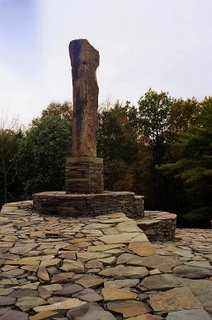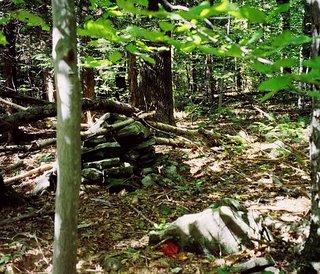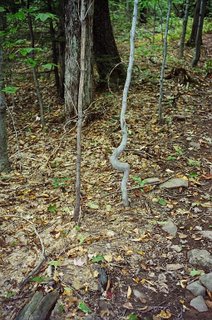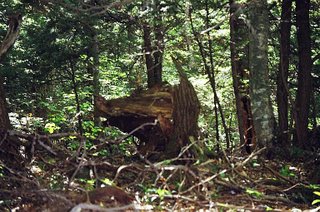
There were several perched boulders here. This one has small stones arranged behind it on the boulder it was perched on.

This boulder sat on another, which was hidden by leaves and debris. What looks like a hole here is really a hollow.

A flat rock leaned on a sort of moon-shaped boulder, with two flat ones buried edge up beside it. What is this?

The same flat rock from the front.

One of many rock piles.

Lining of a stream bed. I've seen this before, more than once.
Well, a person wiser than myself had been telling me for some time that I should go there. But meaning to do something and doing it are two different things, and many months had passed without my making my way to the Bucks County woods. Finally my long-suffering spouse agreed to try it and off we went.
Using Google maps, we had gotten directions, but unfinished road repairs required an unmarked detour and we didn't know our way around. A man and a young girl were doing some kind of cleanup or work at the side of the road, so we stopped and I walked back to ask the way. I mentioned I'd read the place was good for wildflowers. The fellow smiled and said, "It's good for hiking and wildflowers and . . . other things."
There was something in his tone of voice that I didn't ponder at the time. We followed his directions and were soon at our destination.
There were big patches of wildflowers before we even started on the trail. And we weren't far along the main trail before we turned off, first to stand on top of a huge flat boulder, then to investigate other stones and boulder, walls and perched boulders, not to mention the wildflowers: blooodroot, hepatica, both white and piercing blue, wood anemone, rue anemone, spring beauties, sprouts of bellworts and bugbane. One interesting thing led to another delight. I soon slowed up on taking pictures, for fear of running out of room on the picture card. Why hadn't I brought more?
The place abounded with springs and little rills. A ruby-crowned kinglet kept us rapt for five minutes--is it a warbler?
The springs, swamp, and small streams were probably the key to the place as a stone site. The huge boulders of unusual shapes and textures add to the mystique of the site on the landscape. Many of the boulders had flat or concave tops, some of which supported perched rocks or groupings of small rocks, and some of which had accumulated enough soil to host small gardens of wildflowers and ferns.
Further along the path were cairn fields, first on the right as we went in and then another on the left. Off to one side I spotted a low wall, and upon investigation discovered it to be a wiggling serpentine wall. I couldn't determine which end was the head, though, without disturbing a lot of the winter leaf litter, which I did not want to do.
Somewhere along the line as we went from one kind of stone feature to another, Eric said, I guess this is what he meant by hiking and wildflowers and "other things." It hadn't occurred to me that the fellow along the road might know about the stonework, but maybe he did. You don't have to look hard to find it.
We didn't stay long enough to really explore: the Phillies were on at 1:00, and one of us was uninterested in giving that up for a better look at the site. Still, by the time we left, I had a lot of pictures and a good chance of returning late in May, this time with more than one photo card and with a young person just home from college to help me scout around. I'm looking forward to it!

 In the wood near where I live, there's lots of quartz and jasper. The above is an example of the kind of thing that's strewn all around there.
In the wood near where I live, there's lots of quartz and jasper. The above is an example of the kind of thing that's strewn all around there. I brought home some white stones after a long walk picking them up in several areas. Next day when I washed them, I noticed this one. The pictures above and below are the back and front. It's unlikely, I know, but I keep thinking it could be a tool, a kind of scraper. It has a nice edge, and it fits perfectly in my hand.
I brought home some white stones after a long walk picking them up in several areas. Next day when I washed them, I noticed this one. The pictures above and below are the back and front. It's unlikely, I know, but I keep thinking it could be a tool, a kind of scraper. It has a nice edge, and it fits perfectly in my hand.









































